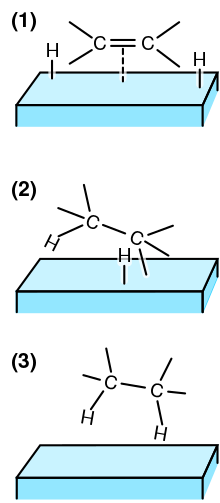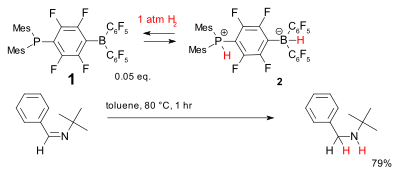Hydrogenation
| Hydrogenation | |
|---|---|
| Conditions | |
| Catalyst | Ni, Pd, Pt |
| Process type | Chemical |
|---|---|
| Industrial sector(s) | Food industry,petrochemical industry,pharmaceuticalindustry, agricultural industry |
| Main technologies or sub-processes | Various transition metal catalysts, high-pressure technology |
| Feedstock | Unsaturatedsubstratesandhydrogenor hydrogen donors |
| Product(s) | Saturated hydrocarbons and derivatives |
| Inventor | Paul Sabatier |
| Year of invention | 1897 |

(1) The reactants areadsorbedon the catalyst surface and H2dissociates.
(2) An H atom bonds to one C atom. The other C atom is still attached to the surface.
(3) A second C atom bonds to an H atom. The molecule leaves the surface.
Hydrogenationis achemical reactionbetween molecularhydrogen(H2) and another compound or element, usually in the presence of acatalystsuch asnickel,palladiumorplatinum.The process is commonly employed toreduceorsaturateorganic compounds.Hydrogenation typically constitutes the addition of pairs ofhydrogenatomsto a molecule, often analkene.Catalysts are required for the reaction to be usable; non-catalytic hydrogenation takes place only at very high temperatures. Hydrogenation reducesdoubleandtriplebonds inhydrocarbons.[1]
Process
[edit]Hydrogenation has three components, theunsaturatedsubstrate, the hydrogen (or hydrogen source) and, invariably, acatalyst.Thereductionreaction is carried out at different temperatures and pressures depending upon the substrate and the activity of the catalyst.
Related or competing reactions
[edit]The same catalysts and conditions that are used for hydrogenation reactions can also lead toisomerizationof thealkenesfromcis to trans.This process is of great interest because hydrogenation technology generates most of thetrans fatin foods. A reaction where bonds are broken while hydrogen is added is calledhydrogenolysis,a reaction that may occur to carbon-carbon and carbon-heteroatom (oxygen,nitrogenorhalogen) bonds. Some hydrogenations of polar bonds are accompanied by hydrogenolysis.
Hydrogen sources
[edit]For hydrogenation, the obvious source of hydrogen isH2gas itself, which is typically available commercially within the storage medium of a pressurized cylinder. The hydrogenation process often uses greater than 1 atmosphere ofH2,usually conveyed from the cylinders and sometimes augmented by "booster pumps". Gaseous hydrogen is produced industrially from hydrocarbons by the process known assteam reforming.[2]For many applications, hydrogen is transferred from donor molecules such asformic acid,isopropanol,anddihydroanthracene.[3]These hydrogen donors undergodehydrogenationto, respectively,carbon dioxide,acetone,andanthracene.These processes are calledtransfer hydrogenations.
Substrates
[edit]An important characteristic of alkene andalkynehydrogenations, both the homogeneously and heterogeneously catalyzed versions, is that hydrogen addition occurs with "syn addition",with hydrogen entering from the least hindered side.[4]This reaction can be performed on a variety of differentfunctional groups.
| Substrate | Product | Comments | Heat of hydrogenation (kJ/mol)[5] |
|---|---|---|---|
| R2C=CR'2 (alkene) |
R2CHCHR'2 (alkane) |
large application is production ofmargarine | −90 to −130 |
| RC≡CR' (alkyne) |
RCH2CH2R' (alkane) |
semihydrogenationgivescis-RHC=CHR' |
−300 (for full hydrogenation) |
| RCH=O (aldehyde) |
RCH2OH (primary alcohol) |
often employstransfer hydrogenation | −60 to −65 |
| R2CO (ketone) |
R2CHOH (secondary alcohol) |
often employstransfer hydrogenation | −60 to −65 |
| RCO2R' (ester) |
RCH2OH + R'OH (two alcohols) |
often applies to production offatty alcohols | −25 to −105 |
| RCO2H (carboxylic acid) |
RCH2OH (primary alcohol) |
applicable to fatty alcohols | −25 to −75 |
| RNO2 (nitro) |
RNH2 (amine) |
major application isaniline[6][7] | −550 |
Catalysts
[edit]With rare exceptions,H2is unreactive toward organic compounds in the absence of metal catalysts. The unsaturated substrate ischemisorbedonto the catalyst, with most sites covered by the substrate. In heterogeneous catalysts, hydrogen forms surface hydrides (M-H) from which hydrogens can be transferred to the chemisorbed substrate.Platinum,palladium,rhodium,andrutheniumform highly active catalysts, which operate at lower temperatures and lower pressures ofH2.Non-precious metal catalysts, especially those based onnickel(such asRaney nickelandUrushibara nickel) have also been developed as economical alternatives, but they are often slower or require higher temperatures. The trade-off is activity (speed of reaction) vs. cost of the catalyst and cost of the apparatus required for use of high pressures. Notice that the Raney-nickel catalysed hydrogenations require high pressures:[8][9]
Catalysts are usually classified into two broad classes:homogeneousandheterogeneous.Homogeneous catalysts dissolve in the solvent that contains the unsaturated substrate. Heterogeneous catalysts are solids that are suspended in the same solvent with the substrate or are treated with gaseous substrate.
Homogeneous catalysts
[edit]Some well known homogeneous catalysts are indicated below. These arecoordination complexesthat activate both the unsaturated substrate and theH2.Most typically, these complexes contain platinum group metals, especially Rh and Ir.
- Homogeneous hydrogenation catalysts and their precursors
-
Dichlorotris(triphenylphosphine)ruthenium(II)is a precatalyst based on ruthenium.
-
Crabtree's catalystis a highly active catalyst featuring iridium.
-
Cyclooctadiene rhodium chloride dimer,Rh2Cl2(cod)2is a precursor to many homogeneous catalysts.
-
(S)-iPr-PHOXis a typical chelating phosphine ligand used in asymmetric hydrogenation.

Homogeneous catalysts are also used in asymmetric synthesis by the hydrogenation of prochiral substrates. An early demonstration of this approach was the Rh-catalyzed hydrogenation of enamides as precursors to the drugL-DOPA.[10]To achieve asymmetric reduction, these catalyst are made chiral by use of chiral diphosphine ligands.[11]Rhodium catalyzed hydrogenation has also been used in the herbicide production of S-metolachlor, which uses a Josiphos type ligand (called Xyliphos).[12]In principle asymmetric hydrogenation can be catalyzed by chiral heterogeneous catalysts,[13]but this approach remains more of a curiosity than a useful technology.
Heterogeneous catalysts
[edit]Heterogeneous catalysts for hydrogenation are more common industrially. In industry, precious metal hydrogenation catalysts are deposited from solution as a fine powder on the support, which is a cheap, bulky, porous, usually granular material, such asactivated carbon,alumina,calcium carbonateorbarium sulfate.[14]For example, platinum on carbon is produced by reduction ofchloroplatinic acidin situin carbon. Examples of these catalysts are 5%rutheniumon activated carbon, or 1%platinumon alumina. Base metal catalysts, such asRaney nickel,are typically much cheaper and do not need a support. Also, in the laboratory, unsupported (massive) precious metal catalysts such asplatinum blackare still used, despite the cost.
As in homogeneous catalysts, the activity is adjusted through changes in the environment around the metal, i.e. thecoordination sphere.Differentfacesof a crystalline heterogeneous catalyst display distinct activities, for example. This can be modified by mi xing metals or using different preparation techniques. Similarly, heterogeneous catalysts are affected by their supports.
In many cases, highly empirical modifications involve selective "poisons". Thus, a carefully chosen catalyst can be used to hydrogenate some functional groups without affecting others, such as the hydrogenation of alkenes without touching aromatic rings, or the selective hydrogenation of alkynes to alkenes usingLindlar's catalyst.For example, when the catalystpalladiumis placed onbarium sulfateand then treated withquinoline,the resulting catalyst reduces alkynes only as far as alkenes. The Lindlar catalyst has been applied to the conversion ofphenylacetylenetostyrene.[15]
- Illustrative hydrogenations
-
Selective hydrogenation of the less hindered alkene group incarvoneusing a homogeneous catalyst (Wilkinson's catalyst).[16]
-
Partial hydrogenation ofphenylacetyleneusing theLindlar catalyst.
-
Hydrogenation of an imine using aRaney nickelcatalyst, a popular heterogeneous catalyst.
-
Partial hydrogenation of aresorcinolderivative using a Raney-Nickel catalyst.
Transfer hydrogenation
[edit]
Transfer hydrogenationuses hydrogen-donor molecules other than molecularH2.These "sacrificial" hydrogen donors, which can also serve assolventsfor the reaction, includehydrazine,formic acid,and alcohols such as isopropanol.[18]
Inorganic synthesis,transfer hydrogenation is useful for theasymmetric hydrogenationof polar unsaturated substrates, such asketones,aldehydesandimines,by employingchiral catalysts.
Electrolytic hydrogenation
[edit]Polarsubstrates such asnitrilescan be hydrogenatedelectrochemically,usingprotic solventsand reducing equivalents as the source of hydrogen.[19]
Thermodynamics and mechanism
[edit]The addition of hydrogen to double or triple bonds inhydrocarbonsis a type ofredoxreaction that can be thermodynamically favorable. For example, the addition of hydrogen to ethene has aGibbs free energychange of -101 kJ·mol−1,which is highlyexothermic.[11]In the hydrogenation of vegetable oils and fatty acids, for example, the heat released, about 25 kcal per mole (105 kJ/mol), is sufficient to raise the temperature of the oil by 1.6–1.7 °C periodine numberdrop.
However, the reaction rate for most hydrogenation reactions is negligible in the absence of catalysts. Themechanismof metal-catalyzed hydrogenation of alkenes and alkynes has been extensively studied.[20]First of allisotope labelingusingdeuteriumconfirms theregiochemistryof the addition:
Heterogeneous catalysis
[edit]On solids, the accepted mechanism is the Horiuti-Polanyimechanism:[21][22]
- Binding of the unsaturated bond
- Dissociation ofH2on the catalyst
- Addition of one atom of hydrogen; this step is reversible
- Addition of the second atom; effectively irreversible.
In the third step, the alkyl group can revert to alkene, which can detach from the catalyst. Consequently, contact with a hydrogenation catalyst allowscis-trans-isomerization. Thetrans-alkene can reassociate to the surface and undergo hydrogenation. These details are revealed in part using D2(deuterium), because recovered alkenes often contain deuterium.
For aromatic substrates, the first hydrogenation is slowest. The product of this step is a cyclohexadiene, which hydrogenate rapidly and are rarely detected. Similarly, thecyclohexeneis ordinarily reduced to cyclohexane.
Homogeneous catalysis
[edit]In many homogeneous hydrogenation processes,[23]the metal binds to both components to give an intermediate alkene-metal(H)2complex. The general sequence of reactions is assumed to be as follows or a related sequence of steps:
- binding of the hydrogen to give a dihydride complex viaoxidative addition(preceding the oxidative addition ofH2is the formation of adihydrogen complex):
- LnM + H2→ LnMH2
- binding of alkene:
- LnMH2+ CH2=CHR → LnMH2(CH2=CHR)
- transfer of one hydrogen atom from the metal to carbon (migratory insertion):
- LnMH2(CH2=CHR) → LnM(H)(CH2−CH2R)
- transfer of the second hydrogen atom from the metal to the alkyl group with simultaneous dissociation of the alkane ( "reductive elimination" )
- LnM(H)(CH2−CH2R) → LnM + CH3−CH2R
Alkene isomerization often accompanies hydrogenation. This important side reaction proceeds bybeta-hydride eliminationof the alkyl hydride intermediate:[24]
- LnM(H)(CH2−CH2R) → LnMH2(CH2=CHR)
- LnMH2(CH2=CHR) → LnMH2+ CH2=CHR
Often the released olefin is trans.
Inorganic substrates
[edit]The hydrogenation of nitrogen to give ammonia is conducted on a vast scale by theHaber–Boschprocess,[25]consuming an estimated 1% of theworld's energy supply.
Oxygen can be partially hydrogenated to givehydrogen peroxide,although this process has not been commercialized. One difficulty is preventing the catalysts from triggering decomposition of the hydrogen peroxide to form water.[26][27]
Industrial applications
[edit]Catalytic hydrogenation has diverse industrial uses. Most frequently, industrial hydrogenation relies on heterogeneous catalysts.[2]
Food industry
[edit]The food industry hydrogenates vegetable oils to convert them into solid or semi-solid fats that can be used in spreads, candies, baked goods, and other products likemargarine.Vegetable oils are made from polyunsaturated fatty acids (having more than one carbon-carbon double bond). Hydrogenation eliminates some of these double bonds.[28]

Partial hydrogenation of a typical plant oil to a typical component of margarine. Most of the C=C double bonds are removed in this process, which elevates the melting point of the product.
Petrochemical industry
[edit]In petrochemical processes, hydrogenation is used to convert alkenes and aromatics into saturated alkanes (paraffins) and cycloalkanes (naphthenes), which are less toxic and less reactive. Relevant to liquid fuels that are stored sometimes for long periods in air, saturated hydrocarbons exhibit superior storage properties. On the other hand, alkenes tend to formhydroperoxides,which can form gums that interfere with fuel handling equipment. For example,mineral turpentineis usually hydrogenated.Hydrocrackingof heavy residues into diesel is another application. Inisomerizationandcatalytic reformingprocesses, some hydrogen pressure is maintained tohydrogenolyzecokeformed on the catalyst and prevent its accumulation.
Organic chemistry
[edit]Hydrogenation is a useful means for converting unsaturated compounds into saturated derivatives. Substrates include not only alkenes and alkynes, but also aldehydes, imines, and nitriles,[29]which are converted into the corresponding saturated compounds, i.e. alcohols and amines. Thus, alkyl aldehydes, which can be synthesized with theoxo processfromcarbon monoxideand an alkene, can be converted to alcohols. E.g.1-propanolis produced from propionaldehyde, produced from ethene and carbon monoxide.Xylitol,apolyol,is produced by hydrogenation of the sugarxylose,an aldehyde. Primary amines can be synthesized byhydrogenation of nitriles,while nitriles are readily synthesized from cyanide and a suitable electrophile. For example, isophorone diamine, a precursor to thepolyurethanemonomerisophorone diisocyanate,is produced from isophorone nitrile by a tandem nitrile hydrogenation/reductive amination by ammonia, wherein hydrogenation converts both the nitrile into an amine and the imine formed from the aldehyde and ammonia into another amine.
Hydrogenation of coal
[edit]History
[edit]Heterogeneous catalytic hydrogenation
[edit]The earliest hydrogenation was that of the platinum-catalyzed addition of hydrogen to oxygen in theDöbereiner's lamp,a device commercialized as early as 1823. The French chemistPaul Sabatieris considered the father of the hydrogenation process. In 1897, building on the earlier work ofJames Boyce,an American chemist working in the manufacture of soap products, he discovered that traces of nickel catalyzed the addition of hydrogen to molecules of gaseous hydrocarbons in what is now known as theSabatier process.For this work, Sabatier shared the 1912Nobel Prize in Chemistry.Wilhelm Normannwas awarded a patent in Germany in 1902 and in Britain in 1903 for the hydrogenation of liquid oils, which was the beginning of what is now a worldwide industry. The commercially importantHaber–Bosch process,first described in 1905, involves hydrogenation of nitrogen. In theFischer–Tropsch process,reported in 1922 carbon monoxide, which is easily derived from coal, is hydrogenated to liquid fuels.
In 1922, Voorhees and Adams described an apparatus for performing hydrogenation under pressures above one atmosphere.[30]The Parr shaker, the first product to allow hydrogenation using elevated pressures and temperatures, was commercialized in 1926 based on Voorhees and Adams' research and remains in widespread use. In 1924Murray Raneydeveloped a finely powdered form of nickel, which is widely used to catalyze hydrogenation reactions such as conversion of nitriles to amines or the production of margarine.
Homogeneous catalytic hydrogenation
[edit]In the 1930s, Calvin discovered that copper(II) complexes oxidized H2.The 1960s witnessed the development of well defined homogeneous catalysts using transition metal complexes, e.g.,Wilkinson's catalyst(RhCl(PPh3)3). Soon thereafter cationic Rh and Ir were found to catalyze the hydrogenation of alkenes and carbonyls.[31]In the 1970s, asymmetric hydrogenation was demonstrated in the synthesis ofL-DOPA,and the 1990s saw the invention ofNoyori asymmetric hydrogenation.[32]The development of homogeneous hydrogenation was influenced by work started in the 1930s and 1940s on theoxo processandZiegler–Natta polymerization.
Metal-free hydrogenation
[edit]For most practical purposes, hydrogenation requires a metal catalyst. Hydrogenation can, however, proceed from some hydrogen donors without catalysts, illustrative hydrogen donors beingdiimideandaluminium isopropoxide,the latter illustrated by theMeerwein–Ponndorf–Verley reduction.Some metal-free catalytic systems have been investigated in academic research. One such system for reduction of ketones consists oftert-butanolandpotassium tert-butoxideand very high temperatures.[33]The reaction depicted below describes the hydrogenation ofbenzophenone:
Achemical kineticsstudy[34]found this reaction isfirst-orderin all three reactants suggesting a cyclic 6-memberedtransition state.
Another system for metal-free hydrogenation is based on thephosphine-borane,compound1,which has been called afrustrated Lewis pair.It reversibly accepts dihydrogen at relatively low temperatures to form thephosphoniumborate2which can reduce simple hinderedimines.[35]
The reduction ofnitrobenzenetoanilinehas been reported to be catalysed byfullerene,its mono-anion, atmospheric hydrogen and UV light.[36]
Equipment used for hydrogenation
[edit]Today's bench chemist has three main choices of hydrogenation equipment:
- Batch hydrogenation under atmospheric conditions
- Batch hydrogenation at elevated temperature and/or pressure[37]
- Flow hydrogenation
Batch hydrogenation under atmospheric conditions
[edit]The original and still a commonly practised form of hydrogenation in teaching laboratories, this process is usually effected by adding solid catalyst to around bottom flaskof dissolved reactant which has been evacuated usingnitrogenorargongas and sealing the mixture with a penetrable rubber seal. Hydrogen gas is then supplied from a H2-filledballoon.The resulting three phase mixture is agitated to promote mi xing. Hydrogen uptake can be monitored, which can be useful for monitoring progress of a hydrogenation. This is achieved by either using a graduated tube containing a coloured liquid, usually aqueouscopper sulfateor withgaugesfor each reaction vessel.
Batch hydrogenation at elevated temperature and/or pressure
[edit]Since many hydrogenation reactions such ashydrogenolysisofprotecting groupsand the reduction ofaromaticsystems proceed extremely sluggishly at atmospheric temperature and pressure, pressurised systems are popular. In these cases, catalyst is added to a solution of reactant under an inert atmosphere in apressure vessel.Hydrogen is added directly from a cylinder or built in laboratory hydrogen source, and the pressurized slurry is mechanically rocked to provide agitation, or a spinning basket is used.[37]Recent advances inelectrolysistechnology have led to the development ofhigh pressure hydrogen generators,which generate hydrogen up to 1,400psi(100 bar) from water. Heat may also be used, as the pressure compensates for the associated reduction in gas solubility.
Flow hydrogenation
[edit]Flow hydrogenation has become a popular technique at the bench and increasingly the process scale. This technique involves continuously flowing a dilute stream of dissolved reactant over a fixed bed catalyst in the presence of hydrogen. Using establishedhigh-performance liquid chromatographytechnology, this technique allows the application of pressures from atmospheric to 1,450 psi (100 bar). Elevated temperatures may also be used. At the bench scale, systems use a range of pre-packed catalysts which eliminates the need for weighing and filteringpyrophoriccatalysts.
Industrial reactors
[edit]Catalytic hydrogenation is done in atubular plug-flow reactorpacked with a supported catalyst. The pressures and temperatures are typically high, although this depends on the catalyst. Catalyst loading is typically much lower than in laboratory batch hydrogenation, and various promoters are added to the metal, or mixed metals are used, to improve activity, selectivity and catalyst stability. The use of nickel is common despite its low activity, due to its low cost compared to precious metals.
Gas liquid induction reactors (hydrogenator) are also used for carrying out catalytic hydrogenation.[38]
See also
[edit]References
[edit]- ^Hudlický, Miloš (1996).Reductions in Organic Chemistry.Washington, D.C.:American Chemical Society.p. 429.ISBN978-0-8412-3344-7.
- ^abPaul N. Rylander, "Hydrogenation and Dehydrogenation" inUllmann's Encyclopedia of Industrial Chemistry,Wiley-VCH, Weinheim, 2005.doi:10.1002/14356007.a13_487
- ^Beck, Shay. Organometallic Chemistry. United Kingdom, EDTECH, 2019.
- ^Advanced Organic ChemistryJerry March 2nd Edition[full citation needed]
- ^Scott D. Barnicki "Synthetic Organic Chemicals" in Handbook of Industrial Chemistry and Biotechnology edited by James A. Kent, New York: Springer, 2012. 12th ed.ISBN978-1-4614-4259-2.
- ^"Hydrogenation of nitrobenzene using polymer bound Ru(III) complexes as catalyst".Ind. Jr. Of Chem. Tech.7:280. 2000.
- ^Patel, D. R. (1998). "Hydrogenation of nitrobenzene using polymer anchored Pd(II) complexes as catalyst".Journal of Molecular Catalysis.130(1–2): 57.doi:10.1016/s1381-1169(97)00197-0.
- ^C. F. H. Allen and James VanAllan (1955)."m-Toylybenzylamine".Organic Syntheses;Collected Volumes,vol. 3, p. 827.
- ^A. B. Mekler, S. Ramachandran, S. Swaminathan, and Melvin S. Newman (1973)."2-Methyl-1,3-Cyclohexanedione".Organic Syntheses
{{cite journal}}:CS1 maint: multiple names: authors list (link);Collected Volumes,vol. 5, p. 743. - ^Knowles, W. S. (March 1986). "Application of organometallic catalysis to the commercial production of L-DOPA".Journal of Chemical Education.63(3): 222.Bibcode:1986JChEd..63..222K.doi:10.1021/ed063p222.
- ^abAtkins, Peter W. (2010).Shriver & Atkins' inorganic chemistry(5th ed.). New York: W. H. Freeman and Co. p. 696.ISBN978-1-4292-1820-7.
- ^Blaser, Hans-Ulrich; Pugin, Benoît; Spindler, Felix; Thommen, Marc (December 2007). "From a Chiral Switch to a Ligand Portfolio for Asymmetric Catalysis".Accounts of Chemical Research.40(12): 1240–1250.doi:10.1021/ar7001057.PMID17715990.
- ^Mallat, T.; Orglmeister, E.; Baiker, A. (2007). "Asymmetric Catalysis at Chiral Metal Surfaces".Chemical Reviews.107(11): 4863–90.doi:10.1021/cr0683663.PMID17927256.
- ^"Platinum Heterogeneous Catalysts – Alfa Aesar".alfa.Archivedfrom the original on 18 January 2018.Retrieved28 April2018.
- ^H. Lindlar and R. Dubuis (1973)."Palladium Catalyst for Partial Reduction of Acetylenes".Organic Syntheses;Collected Volumes,vol. 5, p. 880.
- ^S. Robert E. Ireland and P. Bey (1988)."Homogeneous Catalytic Hydrogenation: Dihydrocarvone".Organic Syntheses;Collected Volumes,vol. 6, p. 459.
- ^Amoa, Kwesi (2007). "Catalytic Hydrogenation of Maleic Acid at Moderate Pressures A Laboratory Demonstration".Journal of Chemical Education.84(12): 1948.Bibcode:2007JChEd..84.1948A.doi:10.1021/ed084p1948.
- ^Wang, Dong; Astruc, Didier (2015). "The Golden Age of Transfer Hydrogenation".Chem. Rev.115(13): 6621–6686.doi:10.1021/acs.chemrev.5b00203.ISSN0009-2665.PMID26061159.
- ^Navarro, Daniela Maria do Amaral Ferraz; Navarro, Marcelo (2004). "Catalytic Hydrogenation of Organic Compounds without H2 Supply: An Electrochemical System".Journal of Chemical Education.81(9): 1350.Bibcode:2004JChEd..81.1350N.doi:10.1021/ed081p1350.S2CID93416392.
- ^Kubas, G. J., "Metal Dihydrogen and σ-Bond Complexes", Kluwer Academic/Plenum Publishers: New York, 2001
- ^Gallezot, Pierre. "Hydrogenation – Heterogeneous" in Encyclopedia of Catalysis, Volume 4, ed. Horvath, I.T., John Wiley & Sons, 2003.
- ^Horiuti, Iurô; Polanyi, M. (1934). "Exchange reactions of hydrogen on metallic catalysts".Transactions of the Faraday Society.30:1164.doi:10.1039/TF9343001164.
- ^Johannes G. de Vries, Cornelis J. Elsevier, eds. The Handbook of Homogeneous Hydrogenation Wiley-VCH, Weinheim, 2007.ISBN978-3-527-31161-3
- ^Hartwig, John (2010).Organotransition Metal Chemistry: From Bonding to Catalysis.New York: University Science Books. p. 1160.ISBN978-1-938787-15-7.
- ^Appl, Max (2006). "Ammonia".Ullmann's Encyclopedia of Industrial Chemistry.Weinheim: Wiley-VCH.doi:10.1002/14356007.a02_143.pub2.ISBN978-3527306732.
- ^Noritaka Mizuno Gabriele Centi, Siglinda Perathoner, Salvatore Abate "Direct Synthesis of Hydrogen Peroxide: Recent Advances" inModern Heterogeneous Oxidation Catalysis: Design, Reactions and Characterization2009, Wiley-VCH.doi:10.1002/9783527627547.ch8
- ^Edwards, Jennifer K.; Solsona, Benjamin; N, Edwin Ntainjua; Carley, Albert F.; Herzing, Andrew A.; Kiely, Christopher J.; Hutchings, Graham J. (20 February 2009). "Switching Off Hydrogen Peroxide Hydrogenation in the Direct Synthesis Process".Science.323(5917): 1037–1041.Bibcode:2009Sci...323.1037E.doi:10.1126/science.1168980.PMID19229032.S2CID1828874.
- ^Ian P. Freeman "Margarines and Shortenings" inUllmann's Encyclopedia of Industrial Chemistry,2005, Wiley-VCH, Weinheim.doi:10.1002/14356007.a16_145
- ^Werkmeister, Svenja; Junge, Kathrin; Beller, Matthias (2 February 2014)."Catalytic Hydrogenation of Carboxylic Acid Esters, Amides, and Nitriles with Homogeneous Catalysts".Organic Process Research & Development.18(2): 289–302.doi:10.1021/op4003278.S2CID102012512.

- ^"Archived copy"(PDF).Archived(PDF)from the original on 2008-09-10.Retrieved2008-08-05.
{{cite web}}:CS1 maint: archived copy as title (link) - ^Schrock, Richard R.; Osborn, John A. (April 1976). "Catalytic hydrogenation using cationic rhodium complexes. I. Evolution of the catalytic system and the hydrogenation of olefins".Journal of the American Chemical Society.98(8): 2134–2143.doi:10.1021/ja00424a020.
- ^C. Pettinari, F. Marchetti, D. Martini "Metal Complexes as Hydrogenation Catalysts" Comprehensive Coordination Chemistry II, 2004, volume 9. pp. 75–139.doi:10.1016/B0-08-043748-6/09125-8
- ^Walling, Cheves.; Bollyky, Laszlo. (1964). "Homogeneous Hydrogenation in the Absence of Transition-Metal Catalysts".Journal of the American Chemical Society.86(18): 3750.doi:10.1021/ja01072a028.
- ^Berkessel, Albrecht; Schubert, Thomas J. S.; Müller, Thomas N. (2002). "Hydrogenation without a Transition-Metal Catalyst: On the Mechanism of the Base-Catalyzed Hydrogenation of Ketones".Journal of the American Chemical Society.124(29): 8693–8.doi:10.1021/ja016152r.PMID12121113.
- ^Chase, Preston A.; Welch, Gregory C.; Jurca, Titel; Stephan, Douglas W. (2007). "Metal-Free Catalytic Hydrogenation".Angewandte Chemie International Edition.46(42): 8050–3.doi:10.1002/anie.200702908.PMID17696181.
- ^Li, Baojun; Xu, Zheng (2009)."A Nonmetal Catalyst for Molecular Hydrogen Activation with Comparable Catalytic Hydrogenation Capability to Noble Metal Catalyst".Journal of the American Chemical Society.131(45): 16380–2.doi:10.1021/ja9061097.PMID19845383.
- ^abAdams, Roger; Voorhees, V. (1928). "Apparatus for catalytic reduction".Organic Syntheses.8:10.doi:10.15227/orgsyn.008.0010.
- ^Joshi, J.B.; Pandit, A.B.; Sharma, M.M. (1982). "Mechanically agitated gas–liquid reactors".Chemical Engineering Science.37(6): 813.Bibcode:1982ChEnS..37..813J.doi:10.1016/0009-2509(82)80171-1.
Further reading
[edit]- Jang ES, Jung MY, Min DB (2005)."Hydrogenation for Low Trans and High Conjugated Fatty Acids"(PDF).Comprehensive Reviews in Food Science and Food Safety.1.Archived fromthe original(PDF)on 2008-12-17.
- examples of hydrogenation from Organic Syntheses:
- early work on transfer hydrogenation:
- Davies, R. R.; Hodgson, H. H. (1943). "76. Catalytic reduction by formic acid under pressure. Part II. A comparison of copper and nickel as catalysts".J. Chem. Soc.:281.doi:10.1039/jr9430000281.
- Leggether, B. E.; Brown, R. K. (1960). "Reduction of Monohalogenated Nitrobenzenes with Hydrazine and Raney Nickel. A Convenient Preparation of Halogenated Anilines".Can. J. Chem.38(12): 2363.doi:10.1139/v60-320.
- Kuhn, L. P. (1951). "Catalytic Reduction with Hydrazine".J. Am. Chem. Soc.73(4): 1510.doi:10.1021/ja01148a029.
External links
[edit]- "The Magic of Hydro",Popular Mechanics,June 1931, pp. 107–109 – early article for the general public on hydrogenation of oil produced in the 1930s





![Selective hydrogenation of the less hindered alkene group in carvone using a homogeneous catalyst (Wilkinson's catalyst).[16]](https://upload.wikimedia.org/wikipedia/commons/thumb/d/d3/CarvoneH2.png/162px-CarvoneH2.png)

![Hydrogenation of nitrogen {\displaystyle {\ce {{\underset {nitrogen}{N{\equiv }N}}+{\underset {hydrogen \atop (200atm)}{3H2}}->[{\ce {Fe\ catalyst}}][350-550^{\circ }{\ce {C}}]{\underset {ammonia}{2NH3}}}}}](https://wikimedia.org/api/rest_v1/media/math/render/svg/2dd5645111a3ad991987a7b9e10599029c287e98)

